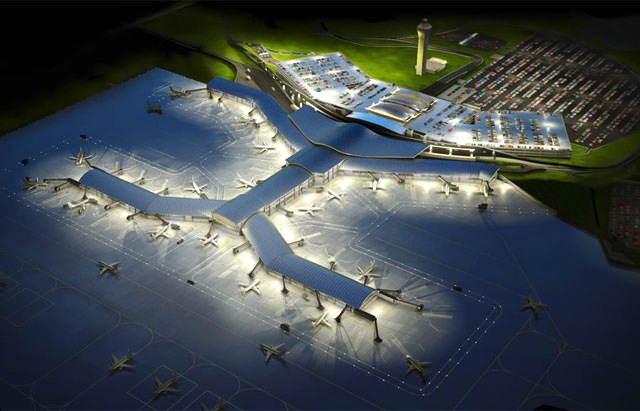There is a very well-researched article in the Kansas City Star this morning that confirms what has been said here all along. Airlines look for profitable passengers, not shiny terminals.
I admit, the first line had me thinking, “Here we go again.” But soon, the truth is revealed.
For years, Kansas City International Airport has been losing passengers and flights from its three 1970s-era terminals.
A single new terminal might help stop the hemorrhaging, say supporters of an airport transformation plan that has sparked a raging debate.
And while every airport is different, they point to recent terminal construction projects at Indianapolis, Sacramento and Raleigh-Durham, N.C. as models for Kansas City to emulate.
So have those new terminals captured more passengers and flights to domestic and international destinations since they opened? Not really.
All three have seen declines or no growth in passenger traffic and nonstop destinations, just as Kansas City has experienced.
Of course, SaveKCI readers read about the issues in Indianapolis back in early April. One consultant in today’s Star article is a bit more blunt.
Mike Boyd, a Denver-based aviation specialist who is not involved with KCI’s plans but is familiar with the airport, agreed that a new terminal doesn’t assure new business. “No, it won’t bring in new airlines,” he said. “They’ve all merged or gone out of business.”
Lest I be accused of taking his quote out of context, he went on to say that KCI must adapt to changing times. I agree as do most people. That is just smart business. What we disagree on is how.
Proponents of the $1.2 billion dollar (before the inevitable cost overruns) single-terminal proposal have said that a shiny new terminal will attract new airlines, new flights and maybe even a hub. Some have since adjusted the promises of dramatic growth saying that we cannot expect to grow or even hold on to current service without the new single-terminal. Meanwhile, I and other commenters on this site have pointed out that airlines simply go where the profitable passengers are. Period.
Chicago has two of the busiest hub airports in the country. One opened in 1931, the other in 1955. They are old, ugly, certainly “outdated” and yet they still work for the airlines. A few years ago, Cincinnati spent half a billion dollars upgrading it’s airport for a new Delta hub. It was indeed an excellent hub experience. Delta then merged with Northwest and found itself with more hubs than it needed. They kept Memphis and pulled out of Cincinnati. Anyone who has flown through both of those can immediately see that Delta did NOT make that decision based on who had the nicer airport and the nicer passenger experience. Now passengers are stuck with Memphis and Cincinnati is stuck with the bills and a shiny new empty airport.
Here are some more examples from the Star article:
• Raleigh Durham. The airport completed a $571 million terminal in 2011 to positive reviews and is renovating another for $68 million. Its passenger traffic dropped from about 10 million in 2007 to 9.1 million in 2010, rebounding slightly to 9.2 million in 2012. It has 39 nonstop destinations and 179 daily departures, about the same as before the terminal completion.
• Sacramento. The airport completed its $1 billion terminal and people-mover project in October 2011, replacing a 1967 terminal. Its passenger traffic was about 8.9 million last year, compared to more than 10 million in 2007, before construction began. It had 140 daily nonstop flights to 28 cities in October 2011, versus 136 daily nonstops to 28 cities now.
• Indianapolis. The $1.1 billion terminal project opened in November 2008. Passenger traffic totaled about 7.2 million in 2012 versus about 8 million in 2008. The airport averaged 189 daily departures to 43 nonstop destinations in 2008, versus 135 departures to 32 destinations now.
I know it’s just a coincidence but it seems from the examples above that the more you spend on a new terminal, the worse the results and more flights that you lose.
In the case of Raleigh-Durham and Sacramento as well as Austin, Texas which is not mentioned in the Star article, these airports are in markets of exploding growth. The airports are simply trying to catch up with demand that is already there. They are not creating demand with the airport.
“Hope” is a theological virtue. It is not a business plan. “Build it and they will come” is an irresponsible approach. Fortunately we are being provided with increasing amounts of evidence, that it’s even more irresponsible with KCI.
Are there problems at KCI that need to be dealt with? Yes. Some, as I pointed out here yesterday, are problems of our own making. If we can figure out how to modernize the ingenius design of the 40 year-old Truman Sports Complex, we can do the same with the ingenius design that is KCI and not put us on the hook for a billion dollars and a lot of hoping.






This is analogous proof, but I worked in professional sports with two teams who were “selling” the idea of new stadiums to their civic leaders. The same parade of promises of increased city revenue, better teams and more participation are made to get bonds and levies passed. It is easy to convince yourself of something that you already want.
The reality is that, and several studies prove this out in sports, that it is simply high expectations and wishes.
The Brookings Institute did a study in 1997 during the stadium boom that came to the conclusion that the net gain for the city was questionable in sports. This is no less true for transportation in which the “best case scenario” is the only viable one; anything less is a failure.
http://www.brookings.edu/research/articles/1997/06/summer-taxes-noll
The issue at hand with KCI is that this promotional “study” already has a conclusion and it will follow the same template of past unnecessary project. While I watch water main burst, pot holes erupt and crime skyrocket, it is no comfort to know that the
predetermined future of KCI is in a singular terminal.
As legacy carriers merge and consolidate in fewer hubs, airline growth will be in point-to-point flights between under-served city pairs.
Once that evolution begins, KCI’s current configuration is perfectly positioned to take advantage of it. There’s no reason to waste $1.2B to chase a dream that will never come true.
Disagree. Costs on these terminals are too high. Airlines look for growth where profitability is. Definitely not here anymore.
I agree that airlines look for profit. However, our landing fees are currently among the lowest in the US. All agree that they will rise if we build a new terminal. Less profit for the airlines unless they raise airfares even more.
Its the cost of operating the airport that is the problem. If we don’t change it, costs of tickets into KC will rise and service will fall. Been in the airline business for many years.
Actually, the opposite is true. Currently KCI is very profitable. So much so that it is able to maintain itself and the downtown airport as well. However, if the airport takes on 1.2 billion in debt, it will need to raise airline landing fees which will yes, result in higher airfares to go along with the increased parking costs. And as has been said here before and the Aviation Department has confirmed, airlines go where the passengers are and where they can fly profitably.